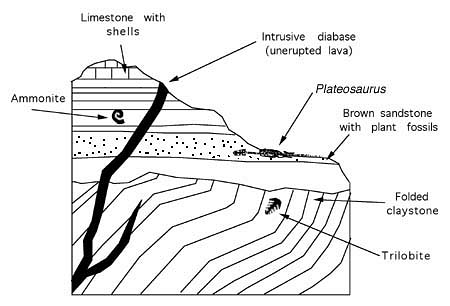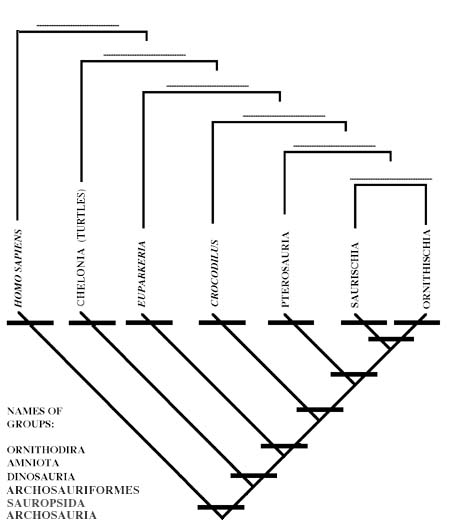
Go to the List of Taxa You Should be Familar With
II. MULTIPLE CHOICE
1. William Smith worked out:
a) the principle of superposition2. What are some of the main regions that have produced Late Triassic age reptile remains.
b) the principle of biotic succession
c) the Ornithischia and the Saurischia
d) the principle of cross-cutting relationships
a) the Moenkopi and the Karoo3. Carbon dioxide (CO2) is:
b) the Morrison and Solnhofen
c) the Chinle, the Atlantic Rift Zone, and the Ischigualasto
d) the Hell Creek, Keuper, and Karoo
a) 28 % of our atmosphere4. A monophyletic group is one in which:
b) limestone
c) < 1 % of our atmosphere
d) produced by photosynthesis
a) some of the members share different common ancestors.5. The Crurotarsi are defined by the following shared derived character.
b) some of the descendants of the common ancestor of the group are not in the group.
c) the common ancestor or the group is not within the group.
d) the common ancestor and all of its descendants are within the group.
1) a mesotarsal ankle joint.III. SHORT ANSWER
2) an ankle with many small bones flexing smoothly at a variety of places.
3) an ankle with a joint between the astragalus and calcaneum.
4) a tendentious ankle.
1. Why is the sail-backed animal Dimetrodon from the Permian of Texas not a dinosaur?
2. What are the main differences between the Ornithodira and Ornithischia?
3. Why is the saurischian triradiate pelvis not a shared derived character which defines the Saurischia?
4. Where would you look for dinosaur fossils and why?
5. How is limestone (= calcium carbonate = CaCO3) related to the greenhouse effect?
IV. SHORT ESSAY
PREPARE A SHORT ESSAY ON ONE OF THE FOLLOWING
TWO QUESTIONS*:
1. Given the cross-section of rock strata exposed in a canyon wall below, outline the history of the area, stating the various basic stratigraphic principles you used and stating the geological periods to which the rock unit belong. The intrusive diabase give a potassium-argon date of 200 million years.

2. There are two main types of ankles seen in the Archosauriformes that are also shared derived characters for several important groups. Define the ankle types, compare and contrast their functionality and the groups they define.
*Other possible topics could include: the carbon cycle;
the different groups of suchians; the different types of skull openings;
Herrerasaurus;
tetrapod postures.
V. DINOSAURIAN RELATIONSHIPS
Fill out the following cladogram with the characters and taxa listed below. Place the number of each character next to the node in the cladogram that defines the taxon and put the taxon name above the appropriate bracket.
 |
CHARACTERS1. Amniotic egg2. Backward pointing pubis 3. Crurotarsal ankle 4. Loss of palatal teeth 5. Mesotarsal ankle 6. No unique derived features 7. One temporal fenestra low on skull 8. Open acetabulum 9. Skull with antorbital opening and upper and lower temporal openings 10. Twisted and enlarged digit 1 on hand 11. Very elongated wing finger 12. Suborbital fenestrae 13. Hard shell covering body |
VI. DINOSAURIAN ANATOMY
You will be asked to label the bones on a drawing of a skeleton much like, but not the same as, the one of Euparkeria you were handed out in class.